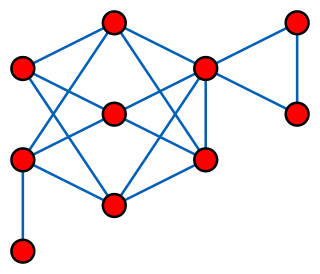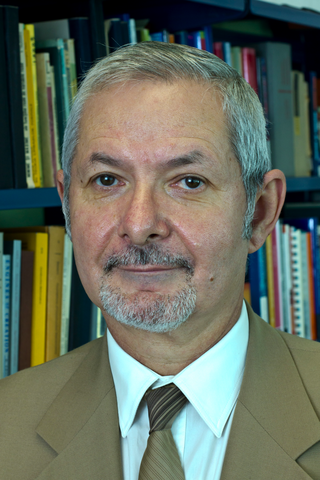Related Research Articles
ICALP, the International Colloquium on Automata, Languages, and Programming is an academic conference organized annually by the European Association for Theoretical Computer Science and held in different locations around Europe. Like most theoretical computer science conferences its contributions are strongly peer-reviewed. The articles have appeared in proceedings published by Springer in their Lecture Notes in Computer Science, but beginning in 2016 they are instead published by the Leibniz International Proceedings in Informatics.
ACM SIGACT or SIGACT is the Association for Computing Machinery Special Interest Group on Algorithms and Computation Theory, whose purpose is support of research in theoretical computer science. It was founded in 1968 by Patrick C. Fischer.
In mathematical logic, monadic second-order logic (MSO) is the fragment of second-order logic where the second-order quantification is limited to quantification over sets. It is particularly important in the logic of graphs, because of Courcelle's theorem, which provides algorithms for evaluating monadic second-order formulas over graphs of bounded treewidth. It is also of fundamental importance in automata theory, where the Büchi–Elgot–Trakhtenbrot theorem gives a logical characterization of the regular languages.

In graph theory, the clique-width of a graph G is a parameter that describes the structural complexity of the graph; it is closely related to treewidth, but unlike treewidth it can be small for dense graphs. It is defined as the minimum number of labels needed to construct G by means of the following 4 operations :
- Creation of a new vertex v with label i (denoted by i(v))
- Disjoint union of two labeled graphs G and H (denoted by )
- Joining by an edge every vertex labeled i to every vertex labeled j (denoted by η(i,j)), where i ≠ j
- Renaming label i to label j (denoted by ρ(i,j))

In graph theory, a branch of discrete mathematics, a distance-hereditary graph is a graph in which the distances in any connected induced subgraph are the same as they are in the original graph. Thus, any induced subgraph inherits the distances of the larger graph.
Michael Stewart Paterson, is a British computer scientist, who was the director of the Centre for Discrete Mathematics and its Applications (DIMAP) at the University of Warwick until 2007, and chair of the department of computer science in 2005.
Michael Ralph Fellows AC HFRSNZ MAE is a computer scientist and the Elite Professor of Computer Science in the Department of Informatics at the University of Bergen, Norway as of January 2016.
The International Symposium on Distributed Computing (DISC) is an annual academic conference for refereed presentations, whose focus is the theory, design, analysis, implementation, and application of distributed systems and networks. The Symposium is organized in association with the European Association for Theoretical Computer Science (EATCS).

The Association Computability in Europe (ACiE) is an international organization of mathematicians, logicians, computer scientists, philosophers, theoretical physicists and others interested in new developments in computability and in their underlying significance for the real world. CiE aims to widen understanding and appreciation of the importance of the concepts and techniques of computability theory, and to support the development of a vibrant multi-disciplinary community of researchers focused on computability-related topics. The ACiE positions itself at the interface between applied and fundamental research, prioritising mathematical approaches to computational barriers.

Cristian Sorin Calude is a Romanian-New Zealander mathematician and computer scientist.

Maurice Paul Nivat was a French computer scientist. His research in computer science spanned the areas of formal languages, programming language semantics, and discrete geometry. A 2006 citation for an honorary doctorate (Ph.D.) called Nivat one of the fathers of theoretical computer science. He was a professor at the University Paris Diderot until 2001.
Hans Leo Bodlaender is a Dutch computer scientist, a professor of computer science at Utrecht University. Bodlaender is known for his work on graph algorithms and parameterized complexity and in particular for algorithms relating to tree decomposition of graphs.
In the study of graph algorithms, Courcelle's theorem is the statement that every graph property definable in the monadic second-order logic of graphs can be decided in linear time on graphs of bounded treewidth. The result was first proved by Bruno Courcelle in 1990 and independently rediscovered by Borie, Parker & Tovey (1992). It is considered the archetype of algorithmic meta-theorems.
The EATCS–IPEC Nerode Prize is a theoretical computer science prize awarded for outstanding research in the area of multivariate algorithmics. It is awarded by the European Association for Theoretical Computer Science and the International Symposium on Parameterized and Exact Computation. The prize was offered for the first time in 2013.

Mohammad Taghi Hajiaghayi is a computer scientist known for his work in algorithms, game theory, social networks, network design, graph theory, and big data. He has over 200 publications with over 185 collaborators and 10 issued patents.
In the mathematical fields of graph theory and finite model theory, the logic of graphs deals with formal specifications of graph properties using sentences of mathematical logic. There are several variations in the types of logical operation that can be used in these sentences. The first-order logic of graphs concerns sentences in which the variables and predicates concern individual vertices and edges of a graph, while monadic second-order graph logic allows quantification over sets of vertices or edges. Logics based on least fixed point operators allow more general predicates over tuples of vertices, but these predicates can only be constructed through fixed-point operators, restricting their power.
Fedor V. Fomin is a professor of Computer Science at the University of Bergen. He is known for his work in algorithms and graph theory. He received his PhD in 1997 at St. Petersburg State University under Nikolai Nikolaevich Petrov.
Daniel Dugué was a French mathematician specializing in probability and statistics. He was born on 22 September 1912 in Saint-Louis in Senegal and died on 10 September 1987 in Paris, France.
Bakhadyr M. Khoussainov is a computer scientist and mathematician, who was born and educated in the Soviet Union, works in the fields of mathematical logic, computability theory, computable model theory and theoretical computer science. With Anil Nerode, he is the co-founder of the theory of automatic structures, which is an extension of the theory of automatic groups.

The Institut de recherche en informatique fondamentale is a French research institute supporting advanced research in computer science. It is located in Paris. It is a public research institute in a partnership with the Université Paris Cité.
References
- 1 2 Bruno Courcelle, text of remarks presented by Maurice Nivat at Courcelle workshop, retrieved 2014-06-24.
- ↑ Bruno Courcelle Archived March 15, 2014, at the Wayback Machine , Institut Universitaire de France, retrieved 2014-06-24.
- ↑ Bruno's workshop, June 18-20, 2012, LaBRI, Bordeaux, retrieved 2014-06-24.
- ↑ "Association CiE website: 2020 S. Barry Cooper Prize awarded to Bruno Courcelle". 3 June 2020. Retrieved 4 Aug 2022.
- ↑ "EATCS-IPEC Nerode Prize" . Retrieved 4 Aug 2022.
- ↑ Amiel, Sandrine (2021-07-26). "Who are France's anti-vaccine rule protesters and what do they want?". euronews. Retrieved 2021-08-09.